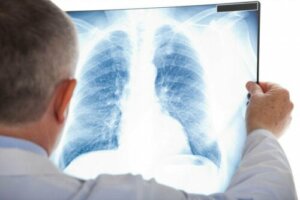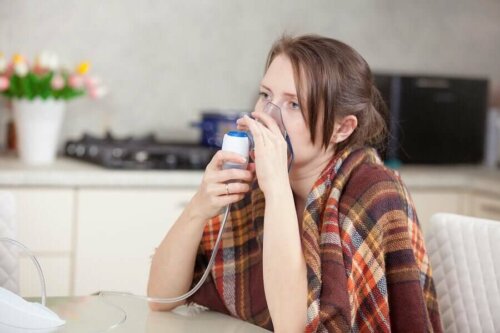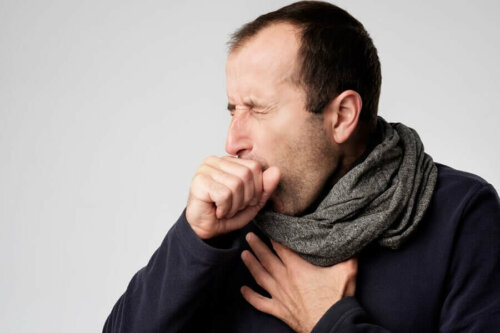What Is Atypical Pneumonia?


Written and verified by the doctor Leonardo Biolatto
Pneumonia is a word that medically refers to an infection of the lungs caused by a virus or bacteria. It’s actually a term that refers to many different etiologies. Therefore, doctors usually divide it into two groups: atypical and typical pneumonia.
The group of atypical pneumonia was named this way at first to refer to those caused by different and less common germs than those of typical pneumonia. However, nowadays, doctors also use it to describe the differences at the symptomatic level between the two.
Atypical pneumonia is mainly caused by Mycoplasma pneumoniae, followed by other atypical germs as well. Outbreaks are more common in the fall and winter. In this article, we’ll explain everything you need to know about this condition and how to identify it.
What causes atypical pneumonia?
As we mentioned, atypical pneumonia is a lung infection that’s caused by less common viruses or bacteria. It’s also called walking pneumonia, and the vast majority of cases occur between fall and winter.
Although the most common cause is an infection by M. pneumoniae, other germs can cause this condition. The germs most associated with it are: Coxiella burnetti, Legionella pneumophila, Chlamydia pneumoniae and Chlamydia psitacci.
As a general rule, atypical pneumonia is usually milder than typical. However, when it’s caused by Legionella, there may be complications and it has a higher mortality rate.
We should note that, on many occasions, this type of pneumonia can appear from a cold that lasts for more than seven or ten days. For example, a cold caused by a respiratory syncytial virus that doesn’t heal properly.

You might like: Silent Pneumonia and Coronavirus
What symptoms does it cause?
Another major difference between atypical and typical pneumonia is the clinical symptoms. They’ll depend, to a great extent, on the area of the lung where the infection is located. That is, if it’s in the highest part of the lungs, there will be greater difficulty breathing.
Most commonly there are cold or flu symptoms such as fever around 38ºC (100.4ºF) and chills. Similarly, you may experience a sore throat or headache, and even pain in the ears or chest. As there is general discomfort, in some cases you might experience loss of appetite and vomiting.
Importantly, the cough in atypical pneumonia is a dry cough. This means that it’s not usually accompanied by phlegm or mucus. In addition, breathing is often difficult and fast.

Discover more: 8 Symptoms of Pneumonia that You Shouldn’t Ignore
How do doctors treat and diagnose atypical pneumonia?
To diagnose atypical pneumonia, it’s essential that the doctor knows all the symptoms. In addition, you should have a complete physical examination including listening to your lungs. That way, they’ll be able to hear the noises your lungs make when you breathe.
When it comes to atypical pneumonia, there’s usually a wheezing sound when you breathe. It sounds similar to the wind. Sometimes they’ll also do a chest x-ray, as they often reveal the infection.
Since the majority of causes are bacteria, the most common treatment is antibiotics. If the infection isn’t very serious, you can take them orally for 7 to 10 days. It’s important to note that atypical pneumonia can be contagious in some cases.
For this reason, we recommend you avoid contact with others and take adequate hygiene measures. Likewise, when you experience any warning symptoms, it’s important to see a doctor to learn about treatment options. That way you can avoid using antibiotics without a prescription.
All cited sources were thoroughly reviewed by our team to ensure their quality, reliability, currency, and validity. The bibliography of this article was considered reliable and of academic or scientific accuracy.
- Gonzalo De Liria, C. R., & Hernández, M. M. (2013). Infecciones causadas por Mycoplasma pneumoniae. Anales de Pediatria Continuada, 11(1), 23–29. https://doi.org/10.1016/S1696-2818(13)70114-8
- ¿En que se diferencia la neumonía atípica de la neumonía común? | Familia y Salud. (n.d.). Retrieved April 28, 2020, from https://www.familiaysalud.es/sintomas-y-enfermedades/sistema-respiratorio/bronquios-y-pulmones/en-que-se-diferencia-la-neumonia
- Neumonía atípica o errante (para Padres) – Nemours KidsHealth. (n.d.). Retrieved April 28, 2020, from https://kidshealth.org/es/parents/walking-pneumonia-esp.html
- Neumonía atípica. (n.d.). Retrieved April 28, 2020, from https://www.brennerchildrens.org/KidsHealth/Parents/Para-Padres/Los-problemas-medicos/Neumonia-atipica.htm
This text is provided for informational purposes only and does not replace consultation with a professional. If in doubt, consult your specialist.








